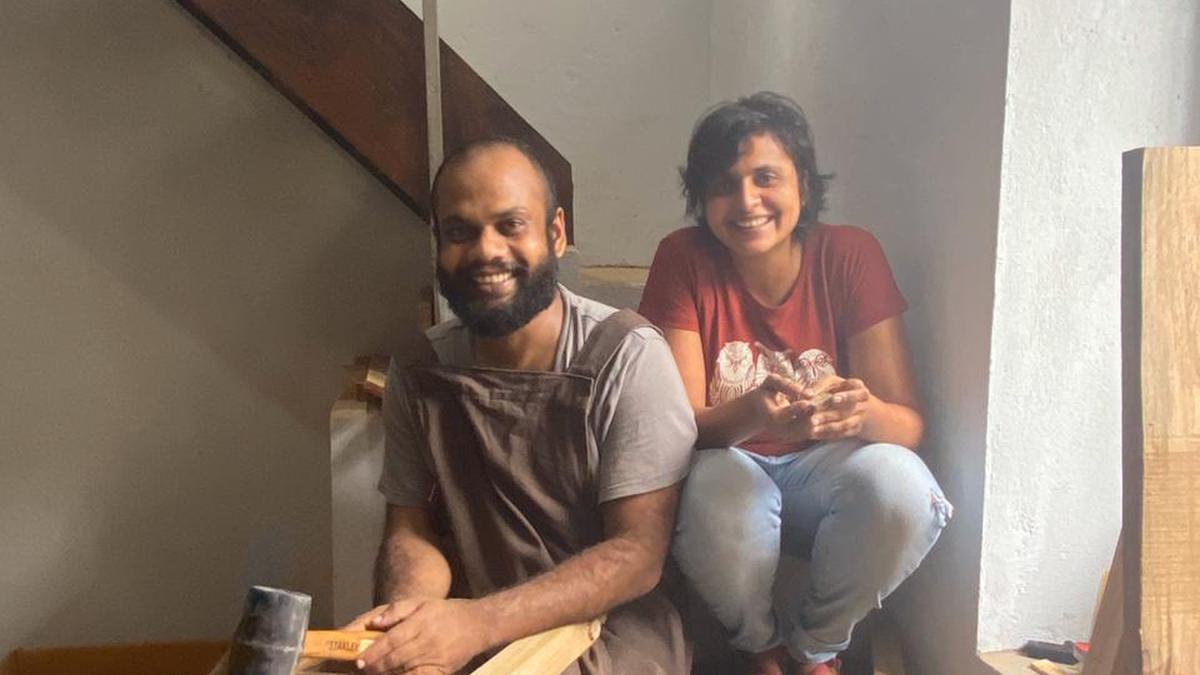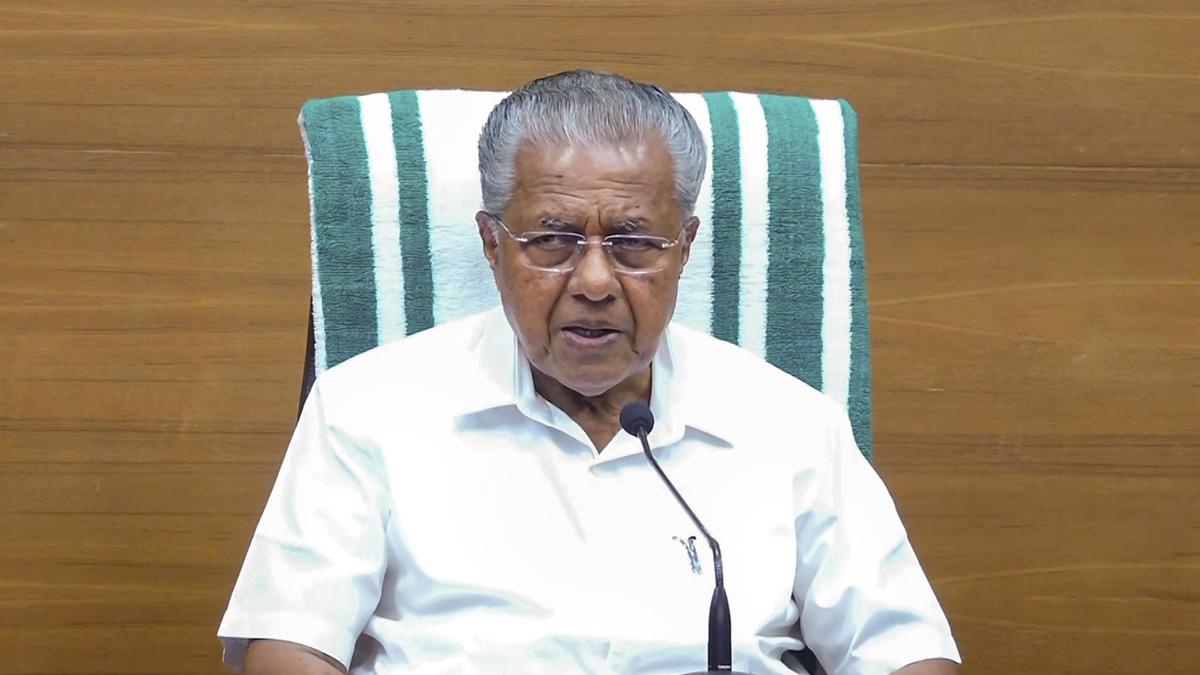As monsoon begins to recede, Kolkata comes undone to the autumnal hues of the month of Ashwin (seventh month of the lunisolar Hindu calendar). Like a flower, the city opens itself to the possibilities of art. Nights are charged with the perfume of shiuli (night flowering jasmine) and at dawn on Mahalaya (held seven days prior to the puja festivities), playwright Birendra Kishore Bhadra’s profound invocation to the goddess rides the wind. This marks the onset of Durga Puja, a festival that Bengal eagerly looks forward to. Over the years Durga Puja has grown to epic proportions with its pandals being nothing short of ornate installations of art.
An artist gives last moment touches to a pandal from 2017
| Photo Credit:
AP
In 2021, UNESCO declared the festival as an Intangible Cultural Heritage of Humanity. The tradition of Durga Puja originated roughly around the 16th century, held by zamindar (land owning gentry) families in colonial Calcutta. Over the years, the puja and puja parikrama (activities) have given the city not only deep creative currents but also new syllables that spell inclusion, festivity and joie de vivre.
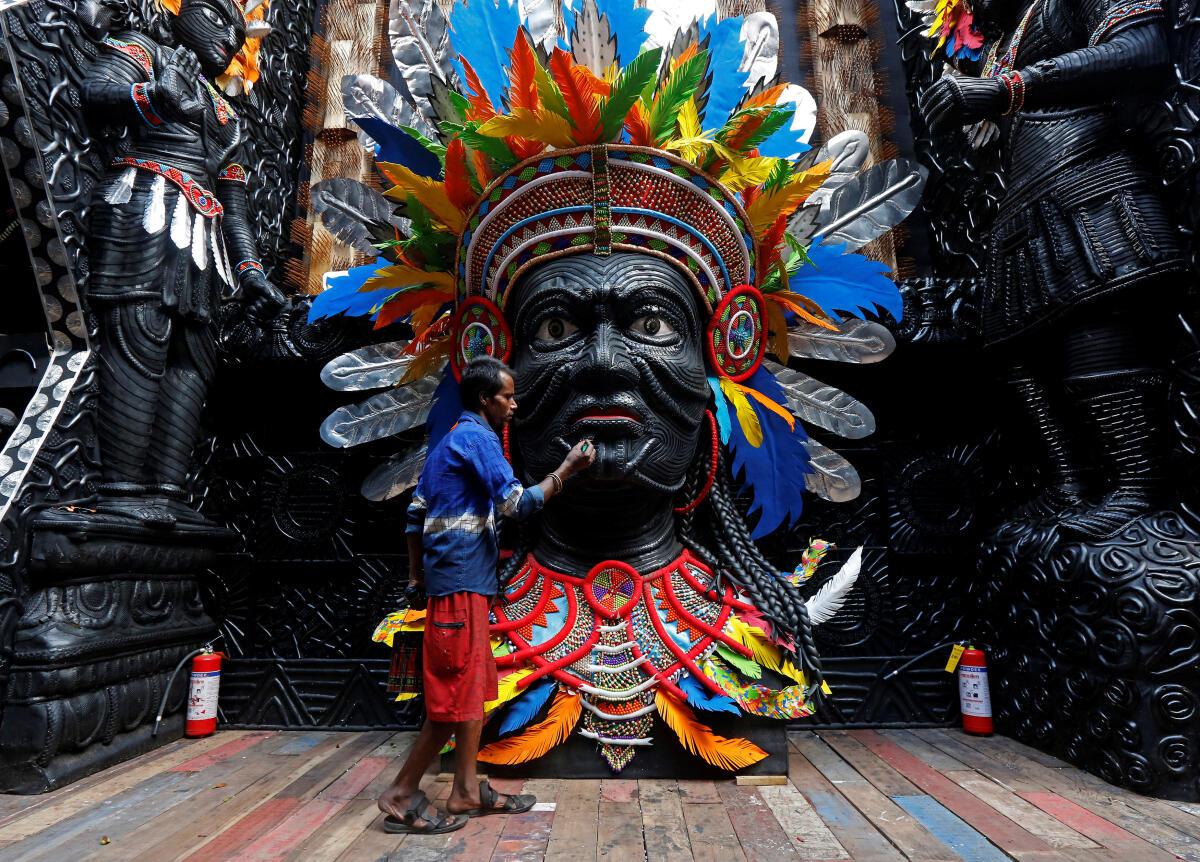
An artisan gives finishing touches to an installation at a pandal
| Photo Credit:
Reuters
According to an MoU signed between the government of West Bengal and British Council in 2019, the creative industries around Durga Puja in West Bengal was estimated to be at ₹32,377 crore which is the size of the economy of many smaller countries across the world. The weeklong festival accounts for 2.58% of the state’s GDP said the report.
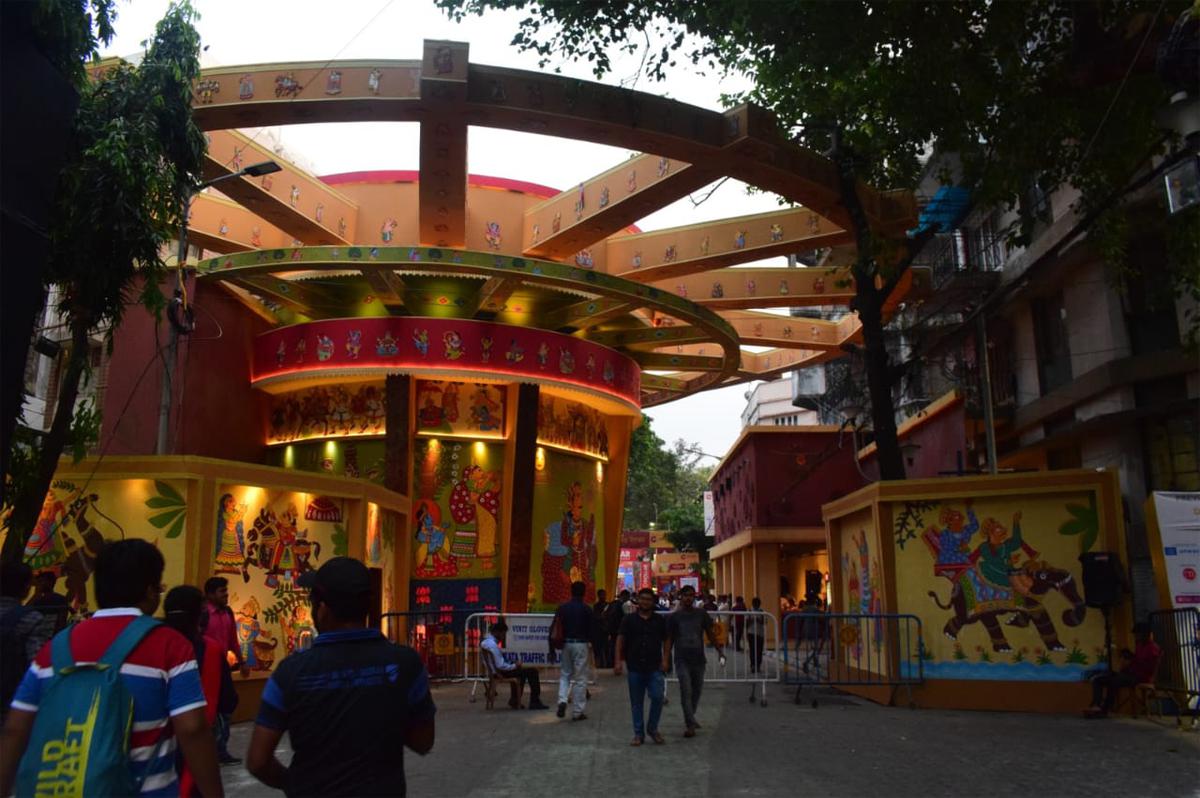
Ballygunge Cultural’s pandal from 2022.
| Photo Credit:
Special Arrangement
Anjan Ukil, joint secretary of Ballygunge Cultural, says, “Now people are keen to see newness. Previously pujas like Bagbajar Sarbojanin had the same idol and same pandal framework, but today people are looking for distinction. Without distinction advertisers, sponsors don’t come forth. Previously we used to gather chanda (donation from neighbourhood homes) and organise puja. Now, that is a thing of the past because pujas have such high budgets that chanda does not suffice. So we are entirely dependent on advertisements. Our budget for the puja is somewhere between ₹60-70 lakh. Our chanda amounts to only ₹2-3lakhs which is less than 10% of the total cost. Earlier the entire puja used to depend on chanda.”
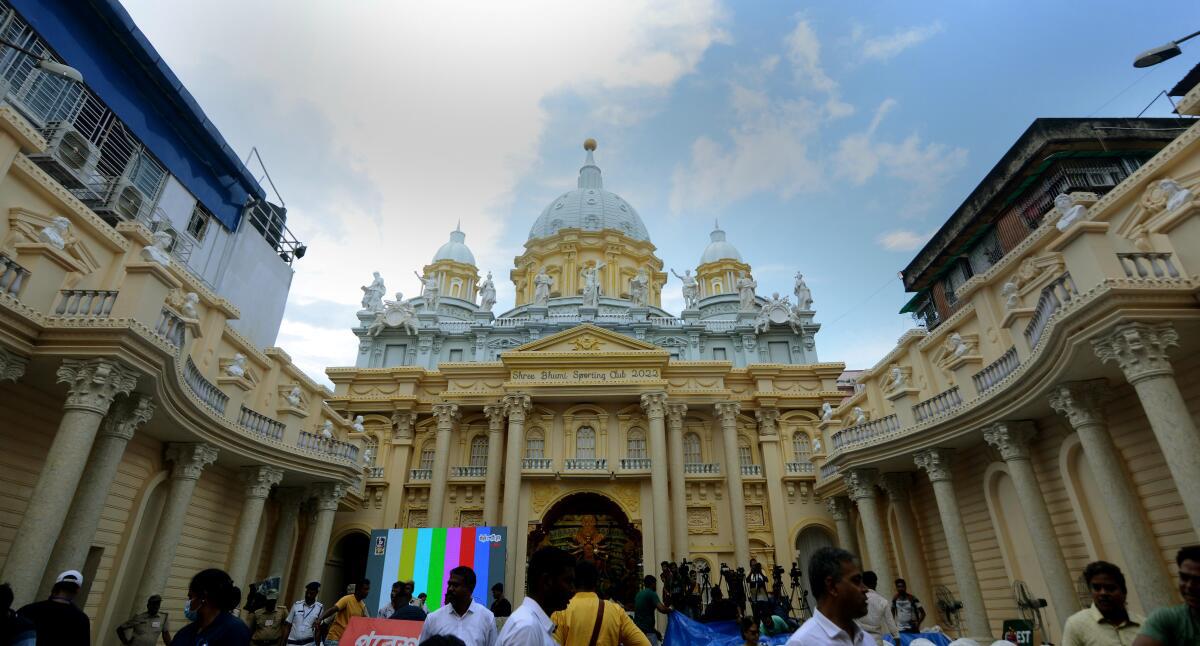
Sreebhumi Sporting Club’s Vatican City themed pandal from 2022
| Photo Credit:
Special Arrangement
Anjan goes on to add, “Previously craftsmen used scraps from saris and fabrics to make pandals. Now professional artists, interior decorators, and architects come together to design the framework. So I cannot call it a ‘pandal’ anymore it falls in the category of art installation and public art. Whoever is able to create the grandest installation attracts large crowds, sponsors and advertisers. We have prize-winning artist Bimal Samanta doing up the pandal which is themed on poems that have lived on through the ages. “
In South Dumdum, Sreebhumi Sporting club is a hot favourite among pandal hoppers. With Burj Khalifa as its theme in 2021 and Vatican City in 2022, the club has been creating a sensorial experience for its spectators with the synergy of light sound, colour and an overwhelming dimension. The club’s theme for this year is Paris Disneyland. Dibyendu Kishore Goswami, secretary of the club says, “Through social media, the whole world has opened up to us. People who travel the world return to tell stories of their experiences. Keeping in mind all those who are unable to travel, we wanted to recreate a model that is a worldwide tourist attraction. If kids are able to see the model, that will generate a wave of happiness.”
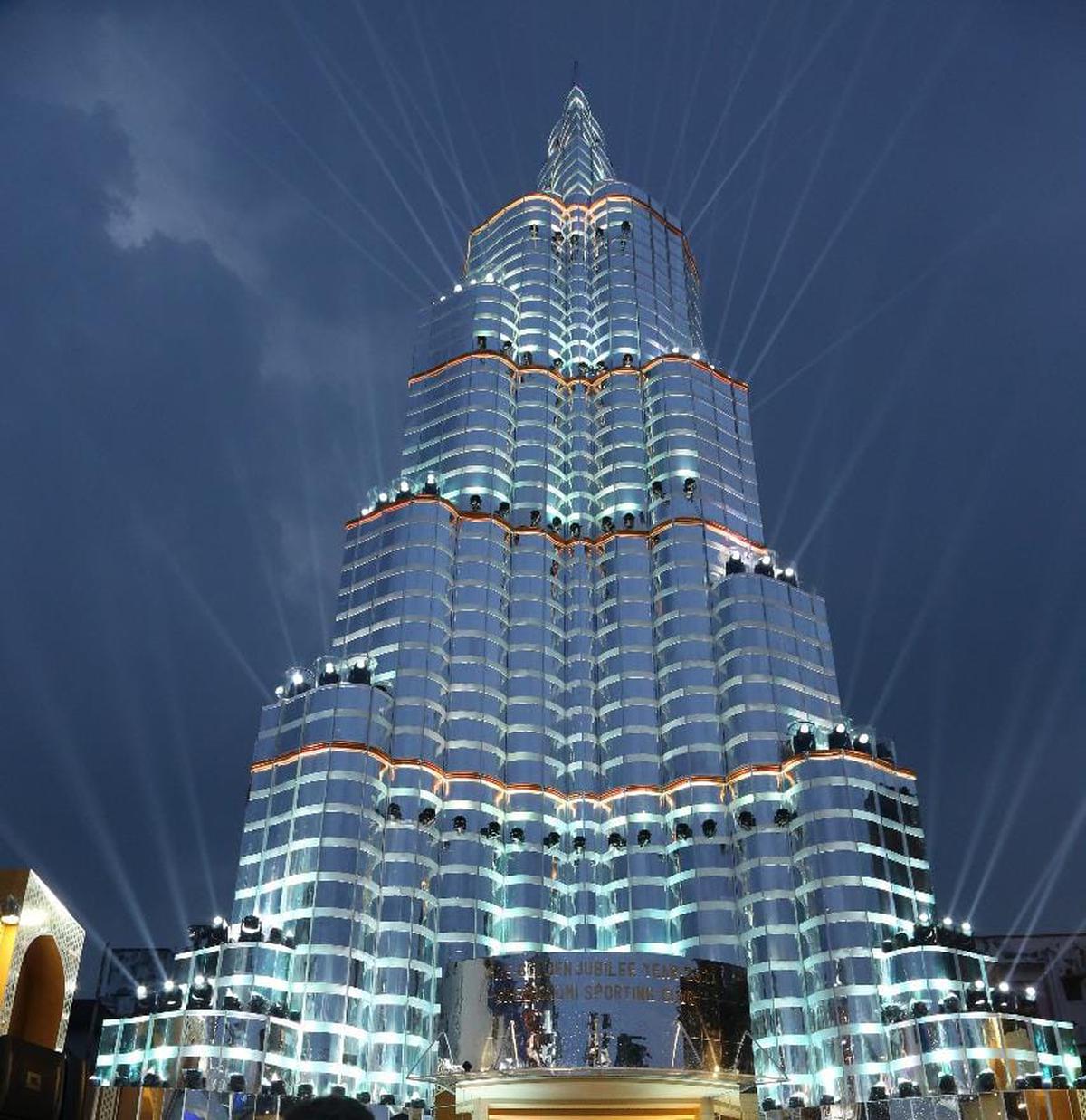
Sreebhumi Sporting Club’s Burj Khalifa Pandal from 2021
| Photo Credit:
Special Arrangement
Main artists of the pandal are Romeo Hazra and Sandip Hazra who give expression to imagination. Ma durga’s idol towers above the ground at approximately 50 feet with no changes in her appearance ever since the club’s inception in 1972. “As far as budget is concerned we cannot tell exact figures until all expenses are carried out. Our sponsors alone generate approximately ₹1.5crore and local chanda is also there. We are unable to include Ma’s (Goddess Durga) ornaments in our budget because it is very expensive. So we have to rely on sponsors who adorn the idol with jewellery and later take it back after the puja is over,” says Dibyendu.
Luminous Club’s Grand Lisboa Hotel themed pandal’s glass interiors shine brilliantly in gold
| Photo Credit:
Sammya Brata Mullick, Manojit Mitra, Ananya Das, Anirban Dey, Soumya Kanti Bhattacharya, Paramita Bishnu
Up north, in Kolkata’s Nadia district, towers a replica of Macau’s Grand Lisboa Hotel that is being put together by Luminous Club. Kanai Chowdhury, social media manager of the club says, “The structure is 182 feet tall and is being made of structures from buses like skirt, crib, side rails and colourful reflecting glass will blanket the interiors and the mandap (platform for rituals).”
Arup Mukherjee, committee member of Luminous Club says, “When we started off in 1992 our theme was traditional and we had to take permission from the Calcutta High Court to organise the puja. Everything depended on High Court permissions and puja was held for three days only with basic arrangements. As we grew we started catering to the changing taste of spectators who want to see something grand and surreal. Last year we had constructed a replica of Malaysia’s Twin Towers which drew large crowds. Pandal hoppers are always in search of something new and social media has helped bring our pandal to people across the country. I cannot disclose our budget figures but this year Senco Gold has sponsored Ma Durga’s pure gold ornaments.”
Bright lights from the Grand Lisboa Hotel themed pandal in Kalyani inundate the night sky
| Photo Credit:
Sammya Brata Mullick, Manojit Mitra, Ananya Das, Anirban Dey, Soumya Kanti Bhattacharya, Paramita Bishnu
With rising budgets and evolving themes, this year’s festivities will transcend boundaries as two artists from the Netherlands — Martyna Maria Pekala and Benjamin Van Hoeij Schilthouwer Pompe — join hands with city artist and sculptor Ayan Saha. Together, they are creating an animated video installation at Behala Natun Dal’s pandal in South Kolkata. Ayan says that the animated video installation is very new to the cultural landscape of Durga Puja. It will interact with the masses and bridge the everyday working individual to the world of art. The installation will primarily weave a story on what the ‘phuchka’ (Kolkata’s answer to the pani puri) means to the city of joy — its cultural, social and local contexts will be outlined using simple motifs that are comical, fun, breezy and easily communicable. Ayan adds that Behala Natun Dal is among 24 community pujas that have been selected for a Durga Puja Preview Art festival in Kolkata.
Sitting like a diadem in the heart of Kolkata is College Square’s Durga Puja. Bikash Majumdar, secretary of the club says, “Every year we have a sabeki pratima (traditional idol) and the theme for this year’s puja is Karnataka’s Mysore Palace. The entire framework of the pandal has been conceptualised and brought to life by Pal decorators of Santipur. The idol has been sculpted by Sanatan Rudra Pal and stands at a height of 23 feet. The perimeter of the pandal framework is 35 by 50 feet and the idol will be placed on a pedestal 55 feet wide. While we cannot disclose exact figures of our budget, costs stand close to ₹70-80 lakhs.” Bikash goes on to recollect that in the initial years pujas were simple and fuss-free. To witness these dramatic settings and themes, crowds start to throng the pandals three days prior to the festivities. To control crowds such pujas rely on Kolkata Police and personnel from civil defence.
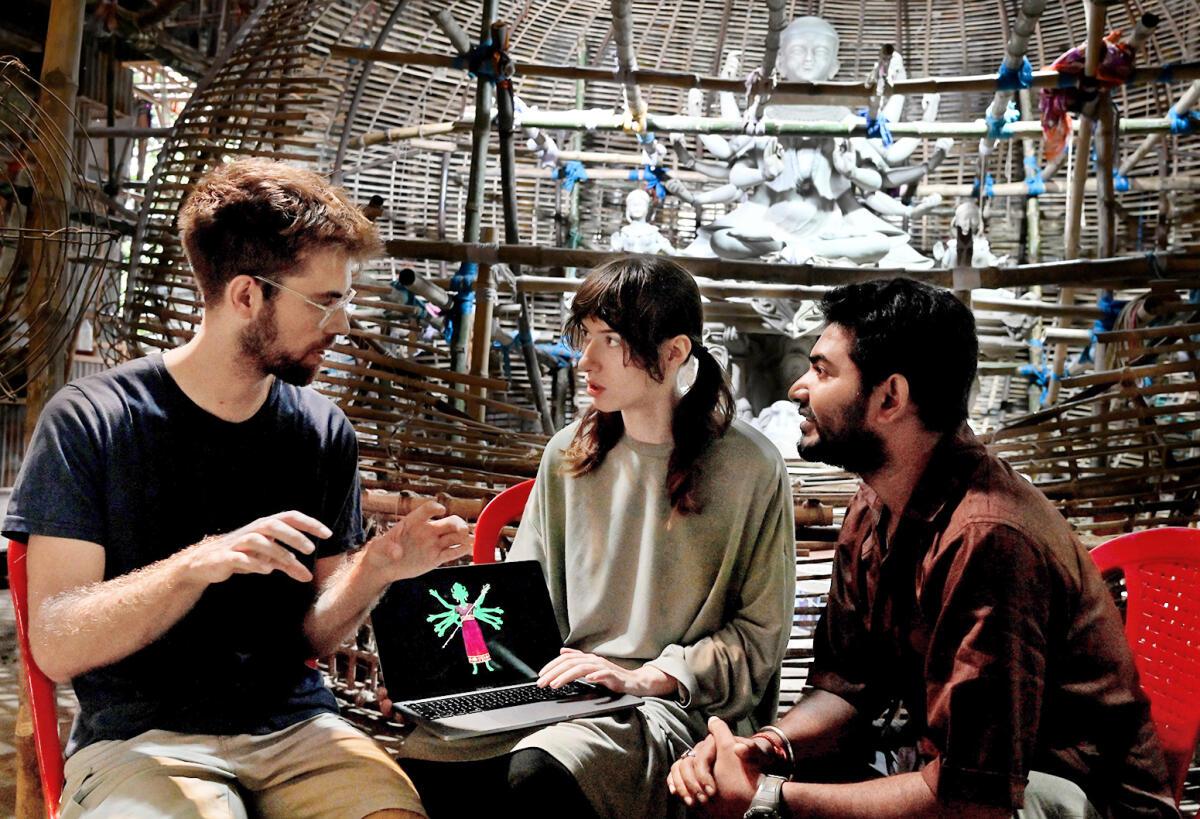
Ayan Saha in conversation with artists Martyna Maria Pekala and Benjamin Van Hoeij Schilthouwer Pompe
| Photo Credit:
The Hindu
As the city gears up for puja, queer artist Nandini Moitra’s recently composed 80-feet-tall wall mural made by a group of trans persons has seamlessly blended with the puja environs. Emblematic of the vicissitudes at the heart of queerness, city dwellers are talking about it interchangably with the upcoming pandal décor in the city, which speaks of an inclusive puja experience.
In the following weeks the old unnoticed sidewalks and gullies of Kolkata will come to life under violet shadows of overarching lights, made by artists of Chandannagar. And as pandal hoppers go from Gariahat junction to Santosh Mitra Square, they never know what they might find at every corner — a towering pandal, an old friend or a child blasting the bhepu (a noisy mouth instrument). Under eaves of colourful nights, the city gives itself over to the beats of the dhaak (drums), dance of the dhunuchis (a traditional dance with frankincense) and the trappings of art, sculpture and creativity.



.jpg)
